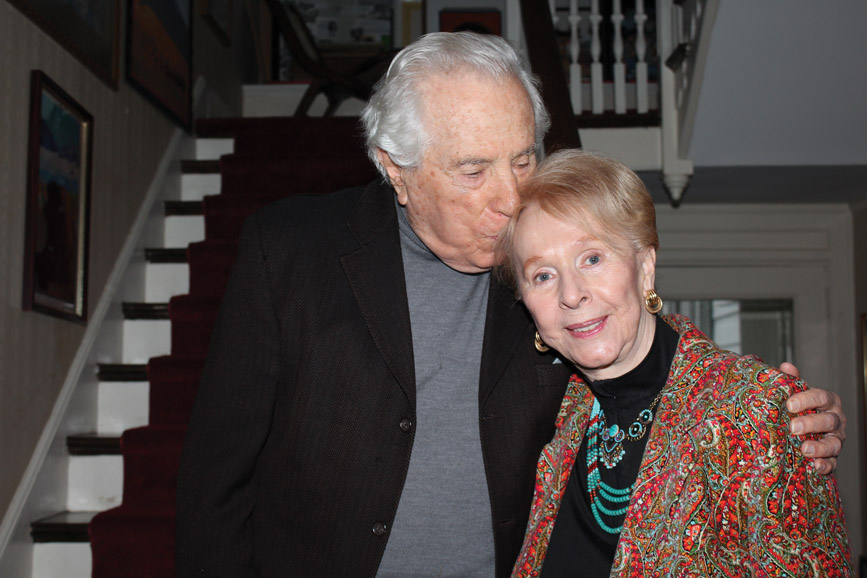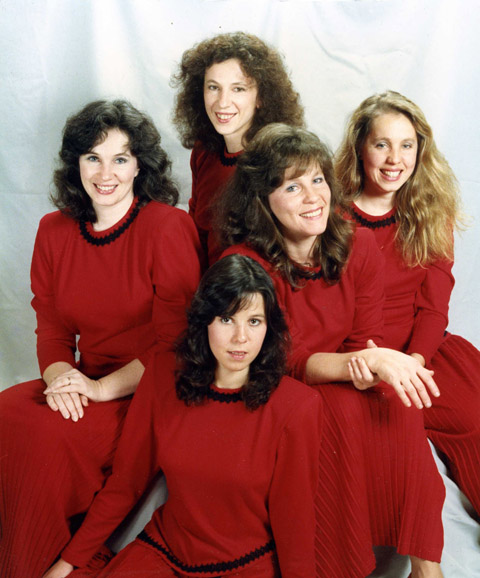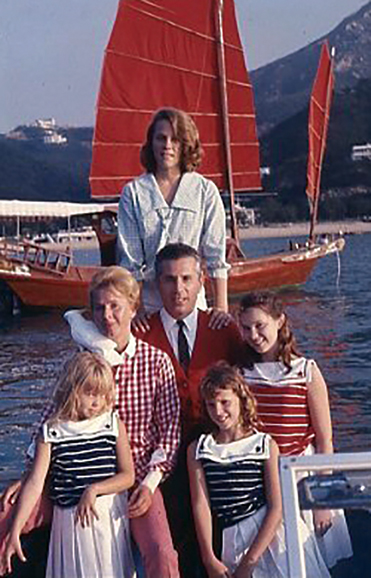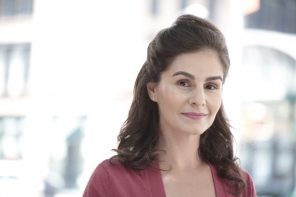A rickshaw full of red roses delivered to a beautiful young woman living in Nanking, China, nearly 70 years ago was the catalyst for the long and happy marriage of Audrey Ronning Topping and Seymour “Top” Topping.
The Toppings, who have lived in Scarsdale for five decades, are best known for their myriad editorial, photojournalistic and documentary filmmaking accomplishments — she as a photojournalist working for National Geographic and The New York Times, among other publications; he as managing editor of The New York Times, among other titles. They have worked as a team on many different and often dangerous assignments in China, Southeast Asia and Europe, including Russia. Through it all, they raised five daughters and now have seven grandchildren and three great-grandchildren.
“But it all really did start with those roses,” Audrey says as she sits next to her husband of 67 years in the serene living room of their exquisitely decorated home filled with treasures from many lands.
“I was a Canadian girl living in China with my family, where my father, Ambassador Chester Ronning, was a senior Canadian diplomat. Top, as I was to discover, was working for the Associated Press covering the Chinese Civil War as a foreign correspondent based in Nanking. We met one night at an elegant dinner party at the American Officers Club in 1947.”
As fate would have it, Audrey and her sister, Meme, were seated at the same table as Top.
“We danced several times that evening and that was the beginning of my deep infatuation with Top,” Audrey says. “The next morning I woke to open the front door and see a rickshaw full to overflowing with beautiful roses and an invitation from Top to a double date with his colleague Bob Clurman, also a journalist. But my sister and I weren’t sure which one of us Top wanted to be his date. The note did not say. So my sister said she would take the tallest one when they arrived.”
Top, who was a bit shorter than his friend, told Audrey later that was exactly what he wanted.
The four young people climbed into a green Jeep and went out dining and dancing the night away, with Audrey on Top’s arm. “And we have been dancing together ever since,” Audrey says.
EARLY YEARS
The chances of a Lutheran with Norwegian roots from Alberta, Canada, and an American Jew born in Harlem and raised in Brooklyn meeting in China, marrying and living “happily ever after” with multiple offspring and successful and demanding careers in far-flung locations are minuscule, but the Toppings pulled it off. Love has kept them together.
“After that first double date, we spent as much time as possible together,” Top says. “After less than a year, I invited her to go up Purple Mountain on the outskirts of Nanking. We spread a blanket, had a picnic and I asked her to marry me. We became engaged after I got her father’s blessing.”
Audrey recalls, “We were engaged for a few months when the Red Army began to head across the Nanking River. I was evacuated in advance of the troops with my mother and siblings while my father stayed on.”
The Ronning family returned to Canada and Audrey enrolled at the University of British Columbia in Vancouver. “At the time, but unknown to me, Top was under house arrest and I did not hear from him for quite a while. I started to believe it was all over between us.”
But, as luck would have it, Audrey was walking down a street in Vancouver one day with a friend and saw a newspaper with a headline about the war in China. “I saw Top’s photo on page one,” she says. “He was described as ‘the luckiest man in the world’ to be alive and had been behind enemy lines all the time I had not heard from him. I went home to find stacks of telegrams he had sent that had just been released.”
Fast forward to a reunion with Top followed by marriage in November of 1949 in Audrey’s hometown of Camrose, Alberta.
“We had a small wedding at my sister’s house and I wore a $60 wedding dress I saw in a shop window,” Audrey says. “We went almost immediately to Hong Kong where we spent Christmas, 1949. Top was assigned to cover the French Indochina War, which lasted from l949 to l951. We had our honeymoon in Angkor Wat, Cambodia.”
Top’s journalistic star was rising and he interviewed the king of Cambodia and the emperor of Indochina during this period. Their early years together were graced with the birth of their first daughter, Susan, born in a French military hospital in Saigon in 1950.
“Saigon was under direct attack not far from the hospital,” Top says. “When Audrey was wheeled into the delivery room, you could hear the artillery fire and feel the hospital shake. The doctor who delivered Susan was also caring for the wounded and his scrubs were stained with their blood. Audrey carried through in her usual courageous manner. After Susan was settled, she insisted I go back to the AP office to report on the battle, which was a critical turning point in the war.”
John F. Kennedy, then a congressman, asked to see Top and congratulate him as a long-serving foreign correspondent, Audrey says. “He saw Susan and told me I had the calm look of a Modigliani portrait. I will never forget that.”
ON TO EUROPE AND RUSSIA
After leaving Southeast Asia, Top was assigned to London to cover the diplomatic beat for the Associated Press. The couple lived in Hampstead and attended the coronation of Queen Elizabeth II. Second daughter Karen was born in Queen Mary’s Nursing Home during the infamous 1952 smog. Queen Mary herself visited baby Karen and gave her a teddy bear.
In 1953, third daughter Lesley was born in the same hospital.
“This was a difficult period because of food rationing,” Audrey says. “I was constantly worried about getting enough food for the children. Even though the war was over, rationing was still in place. During this period, I studied sculpture and used the children as models.”
From l955 through ’58, Top was assigned to cover a divided Germany. “We were given one week to move the entire family and lived in West Berlin,” Audrey says. “We spent time exploring East Germany, helping friends escape. The kids became fluent in German and daughter number four, Robin, was born in the American Military Hospital.”
Their time in Germany drew to a close when Top joined The New York Times in 1960. His assignment was to cover the Cold War in the Soviet Union. The couple lived in Moscow during the heady days of the premiership of Nikita Khrushchev, the first Russians in space and the Cuban Missile Crisis. The children attended Russian schools and made great friends with Russian children, becoming fluent in the language.
During this time, Audrey was a photojournalist and writer working with NBC. She produced a film on the Kremlin along with 16 articles for The New York Times Magazine.
In 1963, Top was assigned to Hong Kong to cover the Vietnam War as The Times’ chief correspondent in Southeast Asia. Audrey got a rare visa for Communist China to write for The Times during the Cultural Revolution.
Top’s career at The Times continued to flourish and he was appointed foreign editor in l966, followed by managing editor. The couple’s fifth daughter, Joanna, was born in l967 after the couple moved to Scarsdale where they have remained ever since.
The ensuing years saw more personal and professional twists and turns, with the couple continuing to work separately and in tandem on a variety of projects, including writing several books.
REFLECTIONS
“I am a fortunate man to be married to Audrey,” Top says. “Not only did she take wonderful care of our children and me in some very difficult circumstances but was a tremendous asset who made all the difference in my professional life. She became a highly skilled journalist and photographer and at certain times was our financial mainstay. When I was appointed foreign editor of The Times in 1966, I cited her as a great asset. She was always absolutely involved in my day-to-day professional life, sometimes in some very dangerous situations. During our periods of separation, she held it all together for our family.”
When asked how she did it, Audrey says, “I don’t know. I just did. Our thinking and view of life has always been the same. We have, of course, had our frictions, but the solution was never to ‘fix it’ with divorce. Five kids makes you think about that as a nonsolution. We never went to bed mad but would talk things out with a drink in front of the fireplace. Talking is key to a successful marriage.”
Top said that Audrey is a woman to be loved and treasured.
“She is the mother of my children and raised them beautifully. She also accomplished some wonderful professional work. She was, and is, beautiful and I have always been deeply in love with her. That was true in l949 and is just as true now, 67 years later.”







